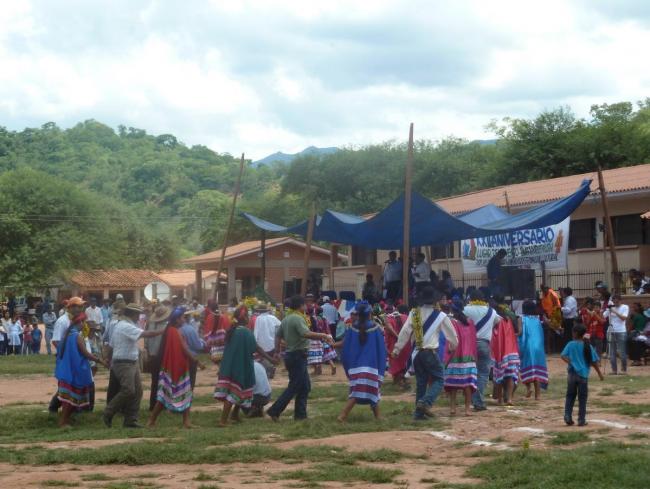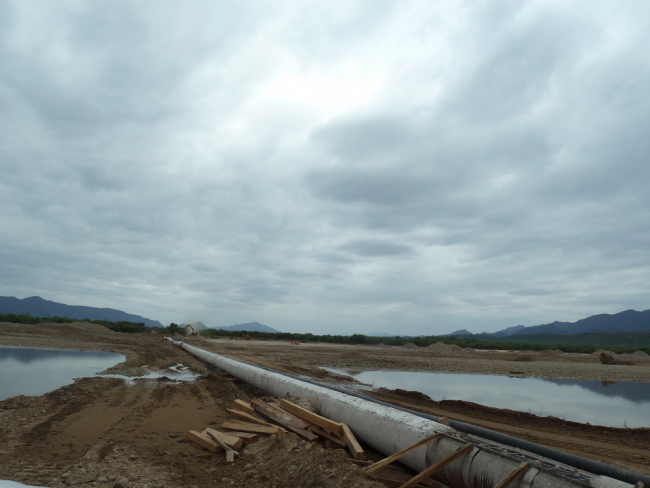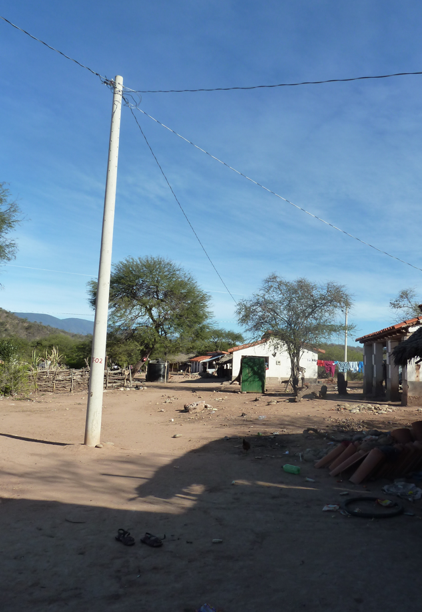
The 2011 TIPNIS conflict exposed the contradiction between the MAS government’s proclaimed commitment to indigenous rights and the environment, and its aggressive pursuit of an extractivist development model. International media images of Evo Morales in indigenous garb were replaced by more familiar images of indigenous peoples mobilizing to defend their territories against the incursions of a capitalist state.
While the TIPNIS conflict is important, the attention given to this case has obscured a more complex set of relations between indigeneity, territory and extraction emerging in the Bolivian lowlands. In the gas-rich Chaco region, indigenous peoples are not simply opposing extraction. Rather, after two decades of hydrocarbon conflicts, they are rethinking their visions of territory and autonomy in the context of an extractivist development model. The results are proving deeply divisive, as strategic alliances with transnational companies are pitted against demands for inclusion in gas-funded state development projects.
These dynamics demonstrate the intimate but unstable relationship between hydrocarbons and citizenship in Bolivia under the Morales government. Alongside the government’s “neo-extractivist” development vision – where national gas rents are channelled into social programs and infrastructure projects – a range of sub-national territorial and political projects is emerging in relation to the governance of gas.
Understanding how indigenous peoples are responding to this new context requires an appreciation of the longer struggle for territory that has unfolded in the Bolivian lowlands over the past three decades. This has centered on Tierras Comunitarias de Origen (Native Community Lands, TCOs), collective indigenous territories recognized under the 1996 Ley del Servicio Nacional de Reforma Agraria (National Agrarian Reform Service Law, INRA), one of several multicultural reforms passed in this period.The legacies and frustrations of TCO land titling are playing an important role in shaping indigenous engagements with an extractivist development model.
The Frustrated Struggle for Territory
While Bolivia’s 1953 Agrarian Reform formally recognized indigenous people as citizens, these communities within the country’s lowland frontier regions continued to be excluded from citizenship in practice. They had no formal land rights or political rights and faced continuing forms of racialized labor exploitation. Along with many other lowland groups, Guaraní communities of the Chaco began to organize beginning in the late 1980s, when they joined a wave of national indigenous mobilizations centered on the demand for territory – a demand that included formal land rights as well as provisions for autonomous territorial governance. Itika Guasu was formally recognized as a TCO in 1997, just a year after the INRA Law passed.
Yet, the legal process for titling land in TCOs was slow, complex and skewed in favor of private claimants, whose property rights are given priority provided they demonstrate productive land use. In TCO Itika Guasu, this legal caveat combined with landowner opposition, political lobbying, and threats of violence to obstruct the legal consolidation of Guaraní land rights. After two decades, the territory remains fragmented and incomplete, with most of the land, including the most productive, in the hands of non-indigenous landowners.
Local opposition was not the only obstacle the Guaraní faced. Just months after TCO Itika Guasu gained official recognition, the Spanish oil giant Repsol, together with partners British Gas and Pan American Energy, acquired rights to develop Campo Margarita, Bolivia’s biggest gas field, which lies beneath Itika Guasu and now accounts for 30 per cent of Bolivia’s total gas production. This was a direct result of the neoliberal reforms of the 1980s and 1990s, which privatized Bolivia’s hydrocarbon sector, opening up the Chaco to investment by transnational companies. TCO status gave indigenous peoples no rights over the subsoil, which remained patrimony of the Bolivian state.
Indigenous peoples did have rights to prior consultation on investments in their territories under International Labor Organization Convention 169, ratified by Bolivia in 1991. However, Repsol managed to bypass the Guaraní organization by signing land use agreements with private land claimants in the TCO. While the APG IG Assembly of Guaraní People Itika Guasu (APG IG) questioned the legality of these agreements, Repsol refused to recognize their claims to consultation and compensation. The result was a decade-long conflict in which the question of land rights in the TCO became intimately connected to the governance of gas.

This conflict continued under the Morales government, which refused to intervene in the conflict with Repsol and accused the APG IG of being a threat to Bolivia’s energy development. The TCO claim remained legally paralysed – a situation that Guaraní leaders attributed to the state’s interests in the territory’s gas reserves.
In 2009, the APG IG demanded the indefinite suspension of the TCO titling process after discovering that properties in the Margarita gas field were on the verge of being titled to private claimants. In a context in which the state seems unwilling to consolidate Guaraní land rights because of its dependence on gas located beneath the territory, APG IG leaders have sought to look beyond the state to strike their own Faustian bargains with transnational oil companies. Such agreements are seen as an alternative form of territorial recognition, worth more than a state land title, and a route to territorial autonomy that evades state-sanctioned processes and forms of economic distribution.
“We have gathered here in the Community of Ñaurenda to celebrate another year of the Assembly of the Guaraní People of Itika Guasu, another year of the People of Itika Guasu, another year of the existence of the Native Community Territory of Itika Guasu.”
It was March 23, 2011 and I was standing on the scrubby ground of the central patio of Ñaurenda community in the Bolivian Chaco, where people from the 36 Guaraní communities of Itika Guasu had gathered to celebrate the 22nd anniversary of their organization. It was here that grandparents had begun organizing in the late 1980s to free themselves from relations of dependency and exploitation with mestizo landowners, who had occupied their territory over the previous century and forced the Guaraní into forms of debt bondage (empatronamiento). This struggle for freedom was the starting point for the elaboration of a collective territorial claim, named “Itika Guasu” after the Pilcomayo River.
My friend Santiago was just old enough to remember the fervor of those early assemblies, when charismatic leaders had galvanized communities to join the struggle for territory. He contrasted his memories with the muted atmosphere of this year’s anniversary. Most of the audience had sat silently through the previous evening’s “cultural event”. When at midnight 22 fireworks exploded, there was little response.
In his annual anniversary speech, the President of the APG IG attempted to lift the mood. He told community members: “This year's anniversary is not like any other; it is a very special year that we will forever remember.” After years of struggle, the APG IG had finally reached an agreement with the Spanish oil company Repsol. The president assured the audience that they had signed the agreement “without giving up any of our rights and instead obtaining full legal recognition of our ownership of the Native Community Territory and of the existence of the APG IG.” He went on to list the terms of the agreement, which included the creation of a $14.8 million Itika Guasu Investment Fund to be managed independently by the APG IG. “This fund,” he explained, “is part of our long-term financing strategy, which will allow us to progress in our own development. This guarantees our true autonomy and that of our children.”
It might be tempting to dismiss this speech as merely an effort to regain legitimacy among community members, many of whom had grown sceptical of their leadership’s opaque dealings with oil companies. Yet, this was more than just a staged performance. Many Guaraní leaders genuinely saw the agreement with Repsol as a symbol of territorial recognition and a route to indigenous autonomy. As they noted, the agreement gives written recognition of the APG IG’s property rights over the entire TCO area – something that the official land titling process never achieved. They also argued that the Investment Fund would enable the APG IG to implement projects in the TCO without relying on conditional handouts from the state. Initial plans included improved medical services and tractors to increase maize production.
Most importantly, they emphasized that the agreement had been negotiated without the help of the state or local NGOs – something made possible by a relationship with the international legal advocacy organization Equipo Nizkor. As one APG IG leader put it: “We negotiated on our own with the company; now we’re managing the money on our own; we made our development plan for the next 20 years on our own.” He saw this as part of the Guaraní’s long struggle to free themselves from exploitative relations with local landowners. “Before you had to work for the patrón, he would pay you in coca…but now you’re working on your own, you’re doing things yourself,” he emphasized.
Santiago made an analogy that the APG IG was like a baby learning to walk – at first stumbling around, but finally finding a surer and more autonomous footing. As he put it, “Finally we can realize our dreams”.
This vision of achieving autonomy through the control of gas wealth represents a departure from the discourses that animated the early days of the Guaraní land struggle, when people talked of “recovering territory” as a space of free movement, cultural reproduction, and land-based livelihoods. How can we make sense of this shift? As I have suggested, it reflects the ultimate failure of TCOs to satisfy indigenous demands for territorial control and autonomy. But it must also be placed in a more contemporary context – one in which political recognition and authority are increasingly being understood in relation to the control and distribution of gas rents.
Hydrocarbon Citizenship
While citizenship and resource extraction have always been connected in Bolivia, the 2005 election of Evo Morales marked a watershed moment in this history. Emerging out of the popular discontent with a neoliberal resource regime, Morales greatly increased the state’s share of oil and gas rents – money that has been channeled into a range of social programs for children, pregnant women, expectant mothers and the elderly. In a 2007 speech, Bolivian Vice President Álvaro García Linera argued that the “socialization” of Bolivia’s hydrocarbon wealth would provide the basis for an “empowered state” and a new, unified national society.
Yet, conflicts around the governance of extraction have not ended. Rather, as Bret Gustafson notes, the influx of gas rents has fuelled a range of competing spatializing projects. Most famously, 2007-2008 saw the emergence of departmental autonomy movements across Bolivia’s resource-rich eastern lowlands. While these movements have subsided amidst political accommodations, less visible conflicts have continued to rage at multiple scales – from peasant communities’ demands for direct cash transfers, to the Chaco’s regional autonomy movement, to an inter-departmental conflict over the geographical limits of the Margarita gas field.
By linking their vision of territorial autonomy to control of gas rents, APG IG is responding to – and attempting to reposition itself within – this national struggle over resource extraction and allocation. They are not alone in doing so. A regional Guaraní council in Tarija has proposed the creation of a Departmental Indigenous Fund consisting of 15% of Tarija’s gas rents to fund the implementation of Territorial Management Plans in TCOs. This proposal replicates – and provides an indigenous-controlled alternative to – the state-supervised national Indigenous Fund (subject to an on-going corruption scandal), which receives a fixed share of Direct Hydrocarbon Tax. In February 2012, the national APG Autonomies Officer described a proposal for the creation of a national Guaraní oil company to conduct extraction within Guaraní territories. As recent events in Itika Guasu show, such debates are becoming a further source of political and territorial fragmentation in the Bolivian Chaco.
State-funded Development
The APG IG President concluded his 2011 anniversary speech with an appeal for unity: “Today, more than ever, we must remain united in order to be able to move forward”. Yet, unity was far from what prevailed. There were various sources of discontent in the TCO. Many community members felt excluded from the leadership committee’s decisions. The introduction of salaries to APG IG leaders exacerbated tensions. Rumors of fiscal mismanagement circulated.
Yet, there was also another concern. As part of their autonomy vision, the APG IG was demanding prior consultation for all projects undertaken within the TCO’s boundaries. This not only proved a headache for state institutions and NGOs; it also obstructed the implementation of development projects in Guaraní communities, which remain among the poorest in Bolivia. Some community members felt they were missing out on valuable state projects, and were unconvinced that the promised projects from the Repsol-financed Itika Guasu Investment Fund would ever arrive.

In 2014, a new group of Guaraní leaders emerged to address such concerns. In addition to promising fiscal transparency and community participation, they promised to work with state authorities to implement a range of development projects in the TCO. In fact, such authorities were instrumental to their rise, providing transport and logistical support for initial assemblies. The old APG IG leadership publicly denounced the rival committee as instruments of a political intervention in their organization. Communities were divided.
Today, the leadership battle in TCO Itika Guasu continues, with each group appealing to different levels of the state and indigenous authorities for support. In some ways, Itika Guasu has become a microcosm of the broader conflicts of Morales’s Bolivia, where many social movements are divided between alignment with the MAS government and opposition to its divisive and increasingly authoritarian tactics. “Paralelismo” – the existence of competing leaderships – has become the new norm. Meanwhile, gas continues to flow from the Margarita gas field to Argentina and Brazil, even if the returning flow of money into Bolivian state coffers is not what it was.
Environmental impacts – including deforestation, water contamination, air pollution, and the loss of wild fauna – continue to accumulate with minimal state oversight, while actors at a variety of scales are building their political projects around control of gas rents. The Guaraní of Itika Guasu did not choose this development model. Communities continue to rely on firewood for fuel. Many are rightly concerned about the long-term impacts of extraction in their territory. Yet, as they are frequently reminded, halting extraction in Bolivia’s biggest gas field is not an option.
What does it mean to struggle for territory and autonomy in this context? The two rival leaderships in Itika Guasu pose different answers to this question: one emphasizes autonomy while the other has promoted inclusion in a national development project. However, both have linked their visions of territorial development to an extractivist development model. Community members, on the other hand, tend to balance the desire for development with concerns about land scarcity, climate change, water contamination and diminishing fish stocks, which pose growing challenges to subsistence livelihoods. Such concerns need to be brought back into the center of indigenous territorial politics if TCOs are to be maintained as spaces for sustainable, healthy and autonomous indigenous futures – the kind of autonomy that grandparents fought for.
Penelope Anthias is Ciriacy-Wantrup Postdoctoral Fellow at the University of California, Berkeley and recently joined the Rule and Rupture project at the University of Copenhagen. Her forthcoming book, Reclaiming Territory: Land, Gas and Indigenous Autonomy in Lowland Bolivia, will be published by Cornell University Press.

